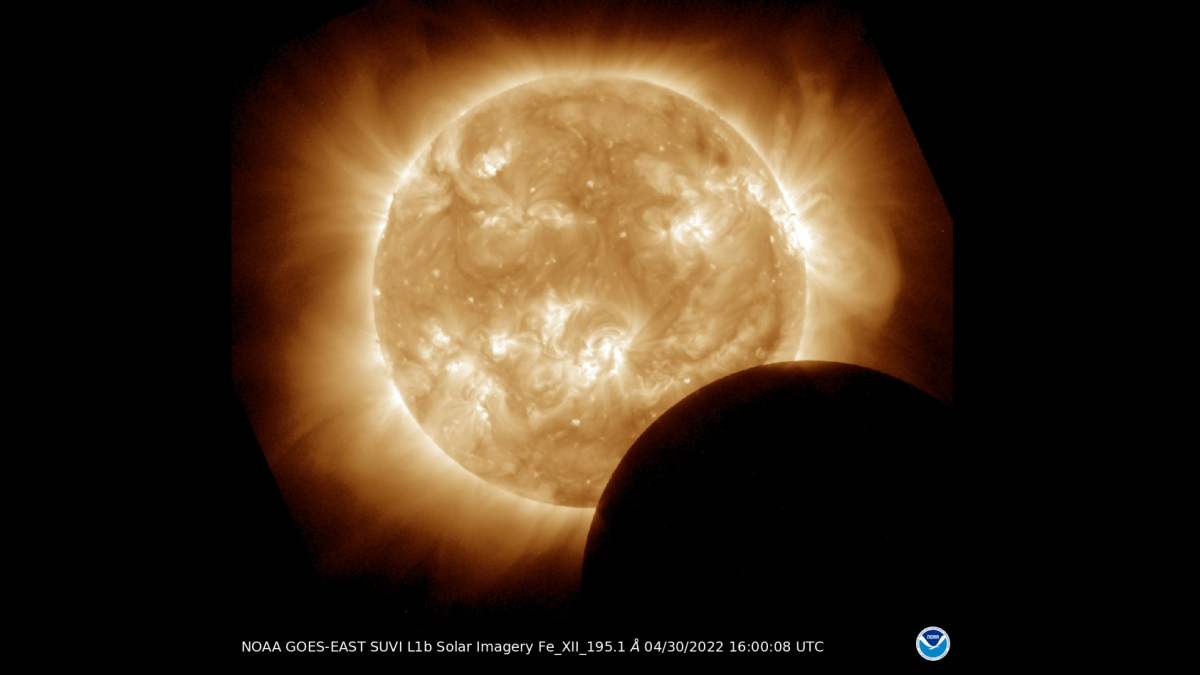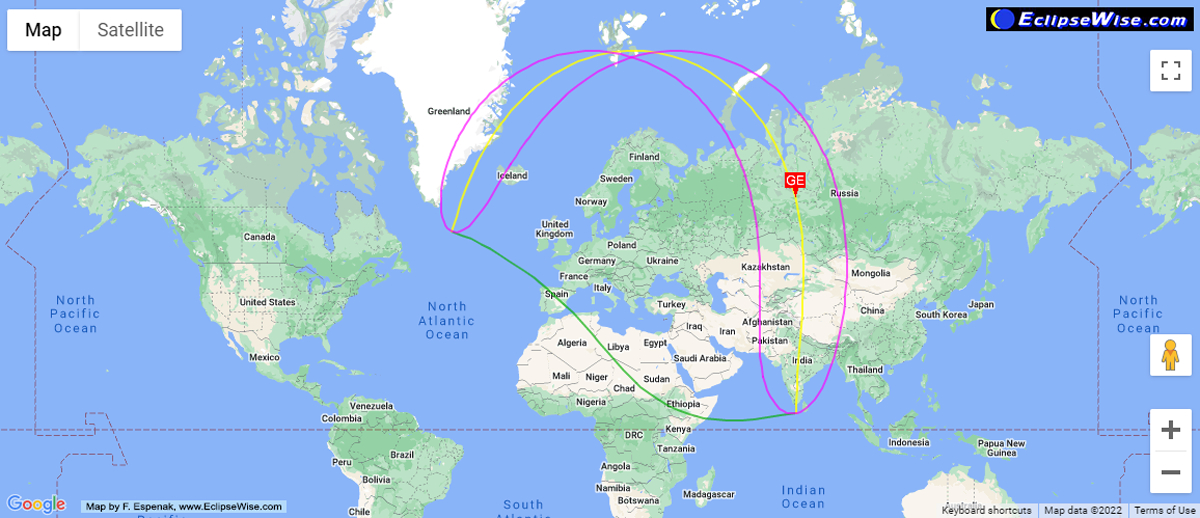What time is the last solar eclipse of 2022 on Oct. 25?
The Oct. 25 solar eclipse is the last one until April 2023. Here's when to see it.

Looking for solar eclipse glasses for the next solar eclipse? This Lunt Solar Systems Solar Eclipse Glasses 5-pack is on sale for 21% off at $7.41 and is ISO certified for safe solar eclipse viewing. Check out our how to observe the sun safely guide for more tips.
The moon will pass in front of the sun in the last solar eclipse of the year on Tuesday (Oct. 25), but you may have to wake up early if you hope to watch it online.
The partial solar eclipse of Oct. 25 is the second and final solar eclipse of 2022 and will be visible to observers across most of Europe, as well as parts of northeast Africa, the Middle East and western Asia. The eclipse begins at 4:58 a.m. EDT (0858 GMT) when the moon first begins to cross the sun as seen from the northern Atlantic Ocean. It will move east over the next four hours, ending at 9:01 a.m. EDT (1301 GMT) just south of India.
If you don't live in those parts of the Earth where the solar eclipse is visible, you do have options to watch it live online. The Royal Observatory Greenwich will host its livestream at 5:05 a.m. EDT (0905 GMT) with astronomers commentating on the event. Astrophysicist Gianluca Masi of the Virtual Telescope Project in Ceccano, Italy will also host a livestream at 5 a.m. EDT (0900 GMT). Finally, if you really want to wake up early, you can join the TimeandDate.com webcast at 4:30 a.m. EDT (0830 GMT) to see the start of the eclipse.
Related: How to watch the last solar eclipse of 2022 online

If you take a photo of the last solar eclipse of 2022 let us know! You can send images and comments to spacephotos@space.com.
Exactly how much of the sun will be eclipsed by the moon depends on your viewing location. At its peak, which occurs at about 11:10 a.m. EDT (1510 GMT), the sun will appear 82% covered by the moon to observers near the North Pole. For observers in Russia, about 80% of the sun will be covered, while in China 70% of the sun will be blocked. Even less of the sun, about 62%, will appear blocked to observers in Finland.
If you are in the visibility area and hope to snap a photo of the eclipse, check out our guide on how to photograph a solar eclipse for helpful tips. Our guides to the best cameras for astrophotography and best lenses for astrophotography can help, too.

As the map above shows, a wide swath of Europe, Asia, the Middle East and northern Africa are in the visibility path for the Oct. 25 solar eclipse. The map, generated by eclipse scientist Fred Espenak of EclipseWise.com using Google Maps, shows the path of maximum eclipse as a yellow line, while the full extent of visibility is bordered by the green and purple.
The exact time of the start of the solar eclipse for observers does depend on location.
Get the Space.com Newsletter
Breaking space news, the latest updates on rocket launches, skywatching events and more!

For example, an eclipse watcher in London can see the start of the eclipse at 10:09 a.m. local time, see maximum eclipse at 10:59 a.m. and see the end of the eclipse at 11:51 a.m. As the eclipse path moves across Earth, those times will be different for each city. In Berlin, the eclipse begins at 11:10 a.m. local time, peaks at 12:14 p.m. and then ends at 1:19 p.m. But in India, where the eclipse visibility path ends, the event will begin for Delhi observers at 4:29 p.m., peak at 5:30 p.m. but its end won't be visible.
Espenak has created a detailed chart solar eclipse times for 38 major cities across Europe, Asia and Africa. You can see that chart at the EclipseWise.com website or check out a shorter list below based on Espenak's chart. All times listed are in local time for each city.
| City, Country | Eclipse Begins | Maximum Eclipse | Eclipse Ends |
| London, U.K | 10:09 a.m. | 10:59 a.m. | 11:51 a.m. |
| Berlin, Germany | 11:10 a.m. | 12:14 a.m. | 1:19 p.m. |
| Paris, France | 11:13 a.m. | 12:03 p.m. | 12:55 p.m. |
| Addis Abeba, Ethiopia | 11:27 a.m. | 11:59 a.m. | 12:29 p.m. |
| Cairo, Eqypt | 12 p.m. | 1:09 p.m. | 2:16 p.m. |
| Moscow, Russia | 12:25 p.m. . | 1:39 p.m. | 2:51 p.m. |
| Kyiv, Ukraine | 1:23 p.m. | 2:37 p.m. | 3:50 p.m. |
| Tel Aviv, Israel | 12: 58 p.m. | 2:11 p.m. | 3:22 p.m. |
| Delhi, India | 4:29 p.m. | 5:30 p.m. | not visible |
| Karachi, Pakistan | 3:58 p.m. | 5:02 | not visible |
If you don't find your city on Espenak's list, don't fret. EclipseWise.com also has a Solar Eclipse Circumstances Calculator for the Oct. 25 eclipse. There you can find start and stop times for the eclipse, including how high the sun will be in the sky, based on your specific location.
Solar eclipses occur when the moon and sun align as the moon passes between the sun and the Earth. When the moon and sun align completely, the sun appears completely blocked, creating a total solar eclipse, but partial solar eclipses can occur when they don't line up perfectly. Because the moon's orbit around Earth is tilted with respect to the sun, the moon and sun do not align every month to create a solar eclipse.
While Tuesday's solar eclipse is the last eclipse of the sun in 2022 (the first was on April 22), it is not the last eclipse in general. On Nov. 8, the moon will pass through Earth's shadow in a total lunar eclipse that will be visible from most of Asia, Australia, North America, South America and parts of northern and eastern Europe.
The next solar eclipse will occur on April 20, 2023, followed by another on Oct. 14, 2023.
Editor's Note: If you get a good photo of the partial solar eclipse and would like to share it with Space.com's readers, send your photo(s), comments, and your name and location to spacephotos@space.com.
Email Tariq Malik at tmalik@space.com or follow him @tariqjmalik. Follow us @Spacedotcom, Facebook and Instagram.
Join our Space Forums to keep talking space on the latest missions, night sky and more! And if you have a news tip, correction or comment, let us know at: community@space.com.

Tariq is the Editor-in-Chief of Space.com and joined the team in 2001, first as an intern and staff writer, and later as an editor. He covers human spaceflight, exploration and space science, as well as skywatching and entertainment. He became Space.com's Managing Editor in 2009 and Editor-in-Chief in 2019. Before joining Space.com, Tariq was a staff reporter for The Los Angeles Times covering education and city beats in La Habra, Fullerton and Huntington Beach. In October 2022, Tariq received the Harry Kolcum Award for excellence in space reporting from the National Space Club Florida Committee. He is also an Eagle Scout (yes, he has the Space Exploration merit badge) and went to Space Camp four times as a kid and a fifth time as an adult. He has journalism degrees from the University of Southern California and New York University. You can find Tariq at Space.com and as the co-host to the This Week In Space podcast with space historian Rod Pyle on the TWiT network. To see his latest project, you can follow Tariq on Twitter @tariqjmalik.









